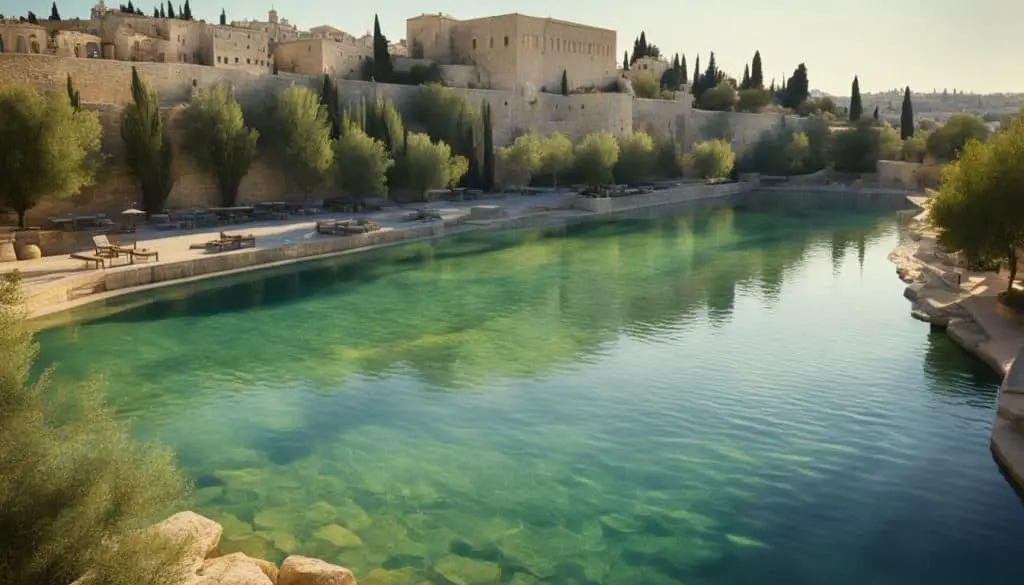Table of Contents
Have you ever wondered about the profound meaning behind the concept of “Living Waters from Zion”?
What if I told you that this biblical symbolism holds the key to understanding the prophecies about Christ’s eternal promise?
Prepare to be amazed as we explore the depths of these living waters and uncover the hidden connections to prophecies that have been foretold since ancient times.
Throughout the Bible, the symbolism of “Living Waters from Zion” can be found in various instances, each carrying a powerful message of hope, renewal, and salvation.
From the spring of Gihon to the rivers flowing from Eden, from Moses striking the rock to the healing waters of the Pool of Siloam, and from the Jordan River to Jesus’ encounter with the Samaritan woman, we will explore how each of these instances reveals a glimpse of Christ’s promise.
Together, we will dive deep into Ezekiel’s vision of a river flowing from the temple, the significance of the river of life in Revelation, the transformative power of baptismal waters, and the symbolism of living waters in communion.
Are you ready to embark on a journey of discovery and encounter the true source of living waters?
Let’s unravel the mysteries and find the answers that have been waiting for us in the pages of Scripture.
The Spring of Gihon: A Prelude to Christ’s Living Water
As we explore the profound symbolism of “Living Waters from Zion” and its connection to Christ’s promise of eternal life, we must begin by examining the significance of the Spring of Gihon. This sacred spring, located outside the walls of Jerusalem, is known for its abundant and continuous flow of water.
The Spring of Gihon holds great importance in biblical history, as it was the site of Solomon’s anointing as the king of Israel. This momentous event symbolized the outpouring of Christ’s spirit that would later bring forth the living water of salvation.
Just as the Spring of Gihon provided physical nourishment and sustenance to the people of Jerusalem, so too does Christ’s living water offer spiritual refreshment and eternal life to all who partake in it.
This spring serves as a prelude, a foreshadowing of the transformative power that comes from embracing Christ’s message and experiencing the fullness of His living water.
“…but whosoever drinketh of the water that I shall give him shall never thirst; but the water that I shall give him shall be in him a well of water springing up into everlasting life.” – John 4:14
Just as the Spring of Gihon flows continuously, never drying up, so too does Christ’s living water flow ceaselessly, offering everlasting life to those who believe in Him. It is a powerful reminder that in Christ, we find sustenance, renewal, and eternal hope.
The Symbolism of the Spring of Gihon
The Spring of Gihon symbolizes the spiritual abundance and life-giving power of Christ’s living water. Just as this spring never ceases to flow, Christ’s living water is an eternal source of nourishment for the soul.
Furthermore, the anointing of Solomon at the Spring of Gihon represents the outpouring of God’s spirit upon the chosen leaders and messengers who bring forth the message of salvation. It signifies the divine authority and empowerment bestowed upon them to fulfill their mission.
| Symbolism of the Spring of Gihon | Meaning |
|---|---|
| Continuous Flow | Christ’s living water is always available, offering eternal life to all who believe. |
| Anointing of Solomon | Represents the outpouring of God’s spirit and divine authority. |
Just as the Spring of Gihon served as a significant source of water for the people of Jerusalem, Christ’s living water is a constant and abundant source of spiritual nourishment and transformation.
Through this living water, we can experience the renewal of our souls and the fulfillment of God’s promise of everlasting life.
Rivers from Eden: Echoes of Christ’s Abundant Life
Expanding on the theme of living waters, we turn our attention to the four rivers that flowed from the Garden of Eden. These rivers hold profound symbolism and offer glimpses into the all-encompassing reach of Christ’s salvation.
Just as the waters of these rivers sustained and nourished the garden, so too does Christ’s abundant life bring renewal and fulfillment to all who believe.
Genesis 2:10-14 describes these four rivers—Pishon, Gihon, Tigris, and Euphrates—that originated in Eden and flowed to various regions. While the physical existence of these rivers is debated, their significance as symbols of life and restoration remains unquestionable.
“And a river went out of Eden to water the garden; and from thence it was parted, and became into four heads…
the name of the second river is Gihon: the same is it that compasseth the whole land of Ethiopia.
And the name of the third river is Hiddekel: that is it which goeth toward the east of Assyria.
And the fourth river is Euphrates.” – Genesis 2:10-14 (KJV)
In biblical literature, water often symbolizes cleansing, restoration, and spiritual abundance. The rivers from Eden, with their life-giving waters, echo the promise of Christ’s salvation.
Just as the rivers extended beyond the boundaries of Eden, so too does God’s grace and salvation extend to all people, regardless of their background or location.
These rivers also foreshadow the abundant life found in Christ. Just as the rivers provided sustenance and growth to the garden, so too does Christ’s salvation bring spiritual nourishment and flourishing to our lives.
Through Christ, we can experience spiritual renewal, fulfillment, and the overflowing abundance of God’s love.
The Symbolism of Each River
Let’s briefly explore the symbolism associated with each of these four rivers:
- Pishon: While its exact location is uncertain, Pishon is believed to have flowed through the land of Havilah, where there was gold and other precious stones. It represents the wealth and abundant provision found in Christ’s salvation.
- Gihon: This river is associated with the land of Cush, which encompasses Ethiopia. Gihon symbolizes the all-encompassing nature of Christ’s salvation, reaching out to every corner of the earth and embracing people from diverse cultures and backgrounds.
- Tigris: This river flowed eastward toward Assyria, signifying the transformative power of Christ’s salvation in bringing healing and restoration to broken lives and communities.
- Euphrates: Known as one of the great rivers of Western Asia, the Euphrates represents the unending and ever-flowing nature of Christ’s salvation. It reflects the eternal presence of God and the continuous outpouring of His grace and love.
As we reflect on the rivers from Eden, let us be reminded of the enduring impact of Christ’s salvation in our lives. Just as these rivers sustained and enriched the garden, may we be refreshed and revitalized by the living waters of Christ. His abundant life offers us hope, healing, and eternal fulfillment.

| River | Symbolism |
|---|---|
| Pishon | Representing the wealth and abundant provision found in Christ’s salvation. |
| Gihon | Symbolizing the all-encompassing nature of Christ’s salvation, reaching out to every corner of the earth and embracing people from diverse cultures and backgrounds. |
| Tigris | Signifying the transformative power of Christ’s salvation in bringing healing and restoration to broken lives and communities. |
| Euphrates | Reflecting the eternal presence of God and the continuous outpouring of His grace and love. |
Moses Striking the Rock: Christ, Our Eternal Source
In the Old Testament, Moses striking the rock at Horeb is a powerful event that foreshadows Jesus as the eternal source of living waters. As the Israelites journeyed through the wilderness, they faced a severe lack of water. In their desperation, they grumbled against Moses, who sought guidance from the Lord.
“Take the staff, and assemble the congregation, you and Aaron your brother, and tell the rock before their eyes to yield its water. So you shall bring water out of the rock for them and give drink to the congregation and their cattle.” – Numbers 20:8 (ESV)
Following God’s command, Moses struck the rock, and water gushed forth to quench the thirst of the entire congregation. This miraculous provision displayed God’s power and love for His people.
Through this extraordinary event, we can discern a profound connection to Jesus. Just as Moses struck the rock to release life-giving water, Jesus, the Rock of our salvation, was struck and pierced on the cross for the forgiveness of our sins.
His sacrificial act became the source of eternal life and the living water that satisfies the deepest longings of our souls.
The Apostle Paul reaffirms this connection, stating, “For I do not want you to be unaware, brothers, that our fathers were all under the cloud, and all passed through the sea, and all were baptized into Moses in the cloud and in the sea, and all ate the same spiritual food, and all drank the same spiritual drink. For they drank from the spiritual Rock that followed them, and the Rock was Christ” (1 Corinthians 10:1-4 ESV).
Just as Moses striking the rock brought forth water in the wilderness, Jesus, as the Rock, brings forth living water that quenches our spiritual thirst and offers us eternal salvation.
| Moses Striking the Rock | Christ, Our Eternal Source |
|---|---|
| Water gushed forth | Eternal life and salvation |
| Provision for physical thirst | Quenches our spiritual thirst |
| Temporary relief | Everlasting satisfaction |
| In the wilderness | In our journey of faith |
The Pool of Siloam: Healing Waters and Messianic Hope
In our exploration of the symbolism of living waters, we cannot overlook the significance of the Pool of Siloam. This sacred pool holds deep meaning in relation to Jesus’ role as the healer and provider, as well as its symbolism connecting to the salvation offered by Christ.
The Pool of Siloam, located in the city of Jerusalem, was a place of great significance for the Jewish people. It was not only a source of physical sustenance but also a symbol of hope and restoration.
The pool’s waters were believed to possess healing properties, making it a destination for those seeking physical and spiritual healing.
One notable event that took place at the Pool of Siloam is recorded in the New Testament. Jesus encountered a man who had been blind from birth and, with great compassion, healed him by anointing his eyes with clay made from His own saliva and instructing the man to wash in the pool’s waters.
When the man obeyed, he received his sight, and his life was forever transformed.
“And he said, ‘Go, wash in the pool of Siloam’ (which is translated, Sent). So he went and washed, and came back seeing.” – John 9:7 (KJV)
This miraculous healing at the Pool of Siloam not only showcases Jesus’ incredible power as a healer but also points to His identity as the long-awaited Messiah.
The prophet Isaiah had foretold that the Messiah would come to open the eyes of the blind and set captives free (Isaiah 42:7). Through this act of healing, Jesus fulfilled this prophecy and revealed Himself as the promised Savior.

This image portrays the beauty and serenity of the Pool of Siloam, inviting us to reflect on the healing and hope found in Jesus Christ.
Furthermore, the Pool of Siloam serves as a metaphor for the salvation offered by Christ. Just as the pool’s waters brought physical healing and restoration, so does Jesus bring spiritual healing and eternal life to all who believe in Him.
The Pool of Siloam becomes a powerful symbol of the living water that Jesus offers, quenching our spiritual thirst and providing the ultimate source of salvation.
As we consider the Pool of Siloam, let us reflect on Jesus’ role as the healer of our brokenness. Let us come to Him, like the man with blinded eyes, seeking both physical and spiritual healing. May we find in Him the living water that sustains and saves.
Jordan’s River: The Pathway to Renewal
As we delve deeper into the profound symbolism found in the Bible’s living waters, the Jordan River emerges as a powerful symbol of new beginnings and purification. In the context of Jesus’ mission and message, his baptism in the Jordan holds significant meaning for believers seeking renewal.
The Jordan River, flowing through the heart of ancient Israel, played a pivotal role in numerous biblical narratives. It served as a boundary marker, a place of crossing, and a symbol of transition.
When Jesus approached the Jordan to be baptized by John the Baptist, he made a profound statement about his ministry and the spiritual journey of his followers.
“I indeed baptize you with water unto repentance: but he that cometh after me is mightier than I, whose shoes I am not worthy to bear: he shall baptize you with the Holy Ghost, and with fire.” – Matthew 3:11 (KJV)
Jesus’ baptism in the Jordan represented a transformative moment, both for him personally and for all those who would follow him. It marked the beginning of his public ministry, as well as a symbolic identification with humanity’s need for cleansing and spiritual renewal.

The imagery of baptism in the Jordan River emphasizes the significance of new beginnings and the washing away of sins. Just as the Jordan was a physical barrier that individuals crossed to reach a new phase of their lives, Jesus’ baptism signified a spiritual crossing into a renewed relationship with God.
The act of baptism in the Jordan continues to hold great symbolism for Christians today. It represents a spiritual rebirth, a cleansing of the old self, and a commitment to follow Jesus on the pathway to renewal.
Through baptism, believers testify to their faith, acknowledging their need for forgiveness and embracing the transformative power of God’s grace.
The Symbolic Power of Jesus’ Baptism in the Jordan River
Jesus’ choice to be baptized in the Jordan River carried profound symbolism that resonates with believers seeking new beginnings and a deeper connection with God:
- New Beginnings: Jesus’ baptism represents a spiritual starting point for both him and his followers, emphasizing the opportunity for renewal and a fresh start in one’s faith journey.
- Purification: By entering the Jordan’s waters and being baptized, Jesus demonstrated his commitment to righteousness and holiness. Believers take this symbolism to heart, seeking purification through repentance and surrender to God’s will.
- Identification with Humanity: Jesus, being sinless, voluntarily identified with humanity’s brokenness and need for redemption. His baptism in the Jordan illustrates his solidarity with humanity and his redemptive mission.
- The Holy Trinity: The baptism of Jesus provides a powerful visual representation of the Holy Trinity. As Jesus emerged from the water, the Holy Spirit descended like a dove, and God the Father declared his approval, affirming the divine nature of Jesus.
The Jordan River serves as a gateway to new beginnings, a pathway to spiritual transformation, and a reminder of Jesus’ redemptive work.
Just as Jesus’ baptism in the Jordan initiated his earthly ministry, it serves as an invitation to believers to embark on their own journey of renewal, continually seeking a deeper relationship with God.
Ezekiel’s Vision: A River Flowing from the Temple
In the book of Ezekiel, we encounter an extraordinary vision that showcases the profound symbolism of a river flowing from the temple. This vision, which Ezekiel received during his exile in Babylon, reveals the abundant life and renewal that come from Jesus Christ, the source of these living waters.
“Afterward he measured a thousand; and it was a river that I could not pass over: for the waters were risen, waters to swim in, a river that could not be passed over” (Ezekiel 47:5, KJV).
In Ezekiel’s vision, the river first emerges as a small stream, ankle-deep, from the temple threshold. As the waters flow, they gradually deepen to knee-level, waist-level, and eventually become a mighty river that cannot be crossed.
This increasing depth represents the inexhaustible abundance and transformative power of Jesus’ life-giving presence.
Just as Ezekiel witnessed the river’s life-giving properties, we too can experience the renewal and spiritual growth that come from immersing ourselves in Christ’s living waters.
Jesus Himself proclaimed, “I am come that they might have life, and that they might have it more abundantly” (John 10:10, KJV).
Through Ezekiel’s vision, we are reminded of the eternal and life-sustaining nature of Christ’s living waters. Jesus offers us not just a temporary source of refreshment but a deep and unending wellspring of life that rejuvenates our souls.
Ezekiel’s vision of the river flowing from the temple stands as a powerful symbol of Jesus as the ultimate source of life and renewal. Just as the river’s increasing depth brings healing and vitality, so too can we experience the transforming power of Jesus’ living waters in our journey of faith.

| Symbolism in Ezekiel’s Vision | Explanation |
|---|---|
| The temple | Represents the dwelling place of God and His presence among His people. It signifies the connection between the divine and the earthly realm. |
| The river | Symbolizes the spiritual life and blessings that flow from Jesus Christ. It represents His abundant provision, healing, and renewal. |
| The increasing depth | Illustrates the limitless nature of Christ’s living waters, which deepen as we immerse ourselves deeper in our relationship with Him. It highlights the transformative power of His presence in our lives. |
| The unpassable river | Emphasizes the inexhaustible abundance of Jesus’ life-giving waters. It communicates that His provision and renewal cannot be surpassed or exhausted. |
As we reflect on Ezekiel’s vision, may we be reminded of the unending flow of life and renewal that Jesus offers. Let us dive deeper into His living waters and experience the transformative power of His presence in our lives.
The Woman at the Well: An Encounter with the Source
In the Gospel of John, we find the intriguing story of Jesus’ encounter with the Samaritan woman at the well. This exchange provides a vivid illustration of Jesus’ offer of living water and his message of salvation for all who believe.
The encounter takes place in Samaria, a region where Jews and Samaritans had a long history of animosity and division. Jesus, weary from his journey, sits by Jacob’s well while his disciples go into the town to buy food. In the scorching midday sun, a Samaritan woman approaches to draw water.

Jesus, breaking cultural norms, initiates a conversation with the woman and asks her for a drink. Intrigued, the woman questions Jesus about the disparity between Jews and Samaritans.
In response, Jesus presents her with a profound revelation: “If you knew the gift of God and who it is that asks you for a drink, you would have asked him and he would have given you living water.”
Curious, the woman questions Jesus further, wondering how he, without a bucket, could draw water from the well. Jesus then explains that the water he offers is different—it is living water that quenches a spiritual thirst and leads to eternal life.
“Everyone who drinks of this water will be thirsty again, but whoever drinks of the water that I will give him will never be thirsty again. The water that I will give him will become in him a spring of water welling up to eternal life.”
The Depth and Accessibility of Jesus’ Living Water
This encounter with the woman at the well emphasizes the depth and accessibility of Jesus’ living water. Regardless of social status, gender, or ethnicity, Jesus offers salvation to all who come to him in faith.
Just as the woman at the well initially sought physical water, we too often search for fulfillment in worldly pursuits, only to find ourselves thirsty once again.
Yet, Jesus offers something far greater—a spiritual satisfaction that endures and brings eternal life. His living water serves as a metaphor for the Holy Spirit, who dwells within believers and brings about a transformation from the inside out.
Through faith in Jesus, we can experience the life-giving power of his presence and receive a satisfaction that surpasses all worldly endeavors.
Jesus’ encounter with the woman at the well reminds us that no matter how parched our souls may be, there is a source of living water available to quench our deepest longings. When we turn to Jesus, our spiritual thirst is satisfied, and we find true fulfillment in him.
| Key Lessons from the Woman at the Well |
|---|
| 1. Jesus offers salvation and spiritual fulfillment to all who come to him. |
| 2. Jesus’ living water satisfies our deepest longings and brings eternal life. |
| 3. Regardless of our past or background, Jesus accepts and invites us into relationship with him. |
The River of Life in Revelation: Eternal Waters of Healing
In the book of Revelation, we encounter a compelling image of a mighty river flowing from the throne of God. This river, known as the River of Life, symbolizes the eternal and abundant provision of God’s healing and restoration. It is a vivid depiction of the living water promised by Jesus Himself.
The River of Life in Revelation is described as crystal clear, flowing with purity and vitality. Its waters bring not only physical healing but also spiritual rejuvenation and renewal. This river is a testament to the everlasting nature of God’s provision and His eternal kingship over all creation.

This image of the River of Life resonates with the promise that Jesus made during His earthly ministry. He declared, “Whoever believes in me, as Scripture has said, rivers of living water will flow from within them” (John 7:38, NIV).
This living water represents the life-giving presence and power of the Holy Spirit, which brings healing, restoration, and eternal life to all who receive it.
The River of Life in Revelation also holds profound significance in terms of our ultimate destiny and hope as believers.
It is described as flowing through the New Jerusalem, the city of God, bringing healing and eternal life to all who dwell there. This imagery paints a picture of the complete restoration of all things and the fulfillment of God’s redemptive plan.
Furthermore, the River of Life in Revelation serves as a striking contrast to the powerful symbol of death and destruction presented earlier in the book – the river of Babylon.
While the river of Babylon represents the fallen world and its corrupt systems, the River of Life represents the ultimate victory of God over sin and death.
In conclusion, the River of Life in Revelation is a powerful symbol of God’s eternal provision, healing, and restoration. It echoes Jesus’ promise of living water and represents the life-giving presence of the Holy Spirit in our lives.
As believers, we can find hope and assurance in the eternal waters of healing that flow from the throne of God, knowing that He is the source of life and that His kingdom will ultimately prevail.
The Baptismal Waters: Dying and Rising with Christ
As we conclude our exploration of the profound symbolism of living waters, we now turn our attention to the transformative power of baptismal waters. Baptism serves as a visible and powerful representation of our participation in Jesus’ death, burial, and resurrection.
Just as Jesus willingly entered the baptismal waters of the Jordan River to identify with humanity and fulfill all righteousness, so too are we called to follow in His footsteps.
Through baptism, we publicly declare our faith in Christ and our commitment to a new life in Him. As we are immersed in the water, we symbolically share in His death, letting go of our old selves, and embracing the promise of new life found in Christ.
The act of baptism becomes a remarkable demonstration of our union with Jesus. In Romans 6:4, the apostle Paul explains, “Therefore we are buried with him by baptism into death, that like as Christ was raised up from the dead by the glory of the Father, even so we also should walk in newness of life.”
Through baptism, we not only identify with Jesus’ death but also experience the power of His resurrection, as we rise from the waters to a new life empowered by the Holy Spirit.
“Know ye not, that so many of us as were baptized into Jesus Christ were baptized into his death? Therefore we are buried with him by baptism into death: that like as Christ was raised up from the dead by the glory of the Father, even so we also should walk in newness of life.” – Romans 6:3-4
Baptismal waters serve as a visible representation of the profound spiritual reality occurring within the believer. Through baptism, we publicly testify to our faith, proclaiming our identification with Jesus’ death, burial, and resurrection. We partake in the transformative power of Christ’s triumphant victory over sin and death.
Furthermore, baptism symbolizes our cleansing from sin and the washing away of our old nature. It is a powerful reminder that, through faith in Jesus, we are made new, forgiven, and set free from the bondage of sin. Just as water cleanses and refreshes, baptism illustrates our purification and renewal in Christ.
In Matthew 28:19-20, Jesus commands His disciples to baptize believers in the name of the Father, the Son, and the Holy Spirit, inviting them into the fellowship of the Triune God. Through baptism, we not only step into a renewed relationship with God but also become partakers in His eternal family.

Baptismal Waters: A Symbol of New Life
Baptismal waters signify the death and resurrection of Jesus, which provide a gateway to new life for all who believe.
It is an outward expression of an inward transformation, a visual representation of the believer’s spiritual rebirth. Through baptism, we are united with Christ, becoming partakers in His eternal life.
As we emerge from the baptismal waters, we are reminded of the hope and promise we have in Jesus. We have died to our old selves, our sins have been washed away, and we are now alive in Christ.
Baptism is an invitation to live victoriously in the power of the Holy Spirit, walking in the newness of life that Christ has granted us.
| Symbolism of Baptismal Waters | Meaning |
|---|---|
| Death and Burial | Identification with Jesus’ death and burial |
| Resurrection | Participation in Jesus’ resurrection and new life |
| Cleansing | Washing away of sin and purification |
| Union with Christ | Identification and fellowship with Jesus |
| New Life | Symbol of spiritual rebirth and transformation |
As believers, let us cherish the profound symbolism of baptismal waters and the privilege it holds in our journey of faith. Let us continually walk in the newness of life, empowered by the indwelling presence of the Holy Spirit, and never cease to marvel at the glorious reality of our union with Christ through baptism.
How Do Symbolism and Prophecy Play a Role in Christian Thought Regarding Zion?
The concept of Zion’s allegories in Christian thought is deeply rooted in symbolism and prophecy. In Christian theology, Zion represents the heavenly city and serves as a symbol of hope, salvation, and the fulfillment of divine promises. Prophecies regarding Zion emphasize the restoration and eternal glory of God’s people.
Living Waters in Communion: Remembering Christ’s Sacrifice
As you gather around the communion table, you enter into a sacred experience, connecting with the living water of Christ’s presence. Communion is not merely a ritual; it is a powerful symbol of Jesus’ offering of himself as the ultimate source of life and renewal.
Through the elements of bread and wine, you are invited to partake in the living water, representing his sacrifice for your salvation.
In this act of remembrance, communion holds deep significance. It is a time to reflect on Christ’s sacrifice, to humble yourself in his presence, and to renew your commitment to follow him.
As you take the bread, you remember his body broken for you, a tangible reminder of his love and the lengths he went to redeem you. And as you partake of the cup, you remember his blood shed for the forgiveness of your sins, the living water that washes you clean and brings you into communion with God.
Communion is not just a historical event to remember; it is an ongoing encounter with the living water of Christ’s presence. As you partake, you receive nourishment for your soul, finding spiritual sustenance and refreshment.
It is a moment of communion with Christ, where you experience his grace, forgiveness, and the assurance of his presence in your life.
So, as you participate in the observance of communion, let it be a sacred time of remembrance, a renewal of your faith, and a deepening of your relationship with the living water of Christ’s presence.
Let it be a reminder that you are loved, forgiven, and called to share in his eternal promise. Communion is a gift, a tangible expression of his sacrifice, and an invitation to partake in the abundant life he offers.




